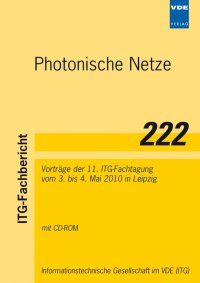Requirements of multi-layer architectures for future OTN networks
Conference: Photonische Netze - 11. ITG-Fachtagung
05/03/2010 - 05/04/2010 at Leipzig, Germany
Proceedings: Photonische Netze
Pages: 9Language: englishTyp: PDF
Personal VDE Members are entitled to a 10% discount on this title
Authors:
Gunkel, M. (Deutsche Telekom AG, Headquarter, Group Technology, Heinrich-Hertz-Strasse 3-7, 64295 Darmstadt)
Nitsch, R.; Herber, R. (T-Systems International GmbH, Systems Integration, Deutsche-Telekom-Allee 7, 64295 Darmstadt)
Abstract:
There is certainly a clear trend of increasing traffic volumes in pure packet transport and higher bitrate capacities that motivates network operators to invest into next-generation optical transport networks (OTN). For packet routing and switching transport, a tree-like aggregation network interconnecting routers/switches would be adequate. Even in this network bypassing traffic on a photonic layer is mandatory for lowering the total energy consumption as well as cost per bit. Besides the packet transport, analysts claim carriers’ carrier and business leased line traffic volume to grow exceptionally fast. These business services, however, show a significantly different geographic distribution compared to carriers’ own platform services. While the internal platform services are quite static, business services are by nature somewhat unpredictable over time. Therefore, future multi-service OTN networks have to augment the configurability and operation flexibility on an agile photonic network layer. This paper defines the requirements of a national OTN network derived from the expected services. Without the claim of completeness, various transport network architectures are presented currently under investigations. Amongst them is an architecture integrating the business traffic directly into the hierarchically-structured packet transport platform via aggregation rings. This concept acknowledges the dominance of the internal platform traffic and does not primarily reflect the special needs for leased lines services. Second is a nation-wide transparent architecture flat on the optical layer. More realistic architectures rely on transparency domains which are i) partly meshed metro domains together with a separate dedicated backbone hierarchy built from one or several domains or ii) a multi-domain network without demarcating hierarchies connected by special inter-domain exchange sites. Finally, we present first results showing reasonably tailored transparency domains over the German landscape.


